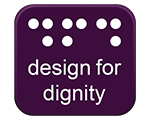Design For Dignity
Retail Guidelines




Some shopping centres provide touch-screen information directories to allow customers to navigate and find their way around. These directories should be placed at a height that is accessible from a seated position and not reflect the glare of overhead lighting when viewed at that level. Some screens offer an accessibility option represented by the International Access symbol so that people can operate the controls whilst seated. AND's experience of these alternatives is that they don't always provide the same information and often don't work well.
The information is usually only accessible for people who are able to see the screen as they are touchscreen applications with no braille or tactile controls or audio directions. Directions are also sometimes very complex, in three dimensions or not oriented in the same direction as the person viewing the map.